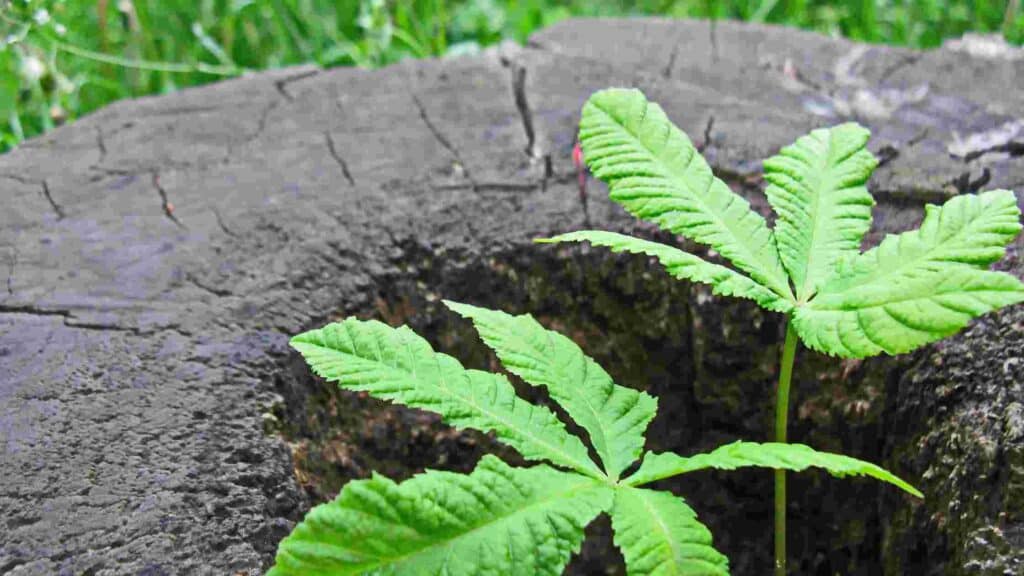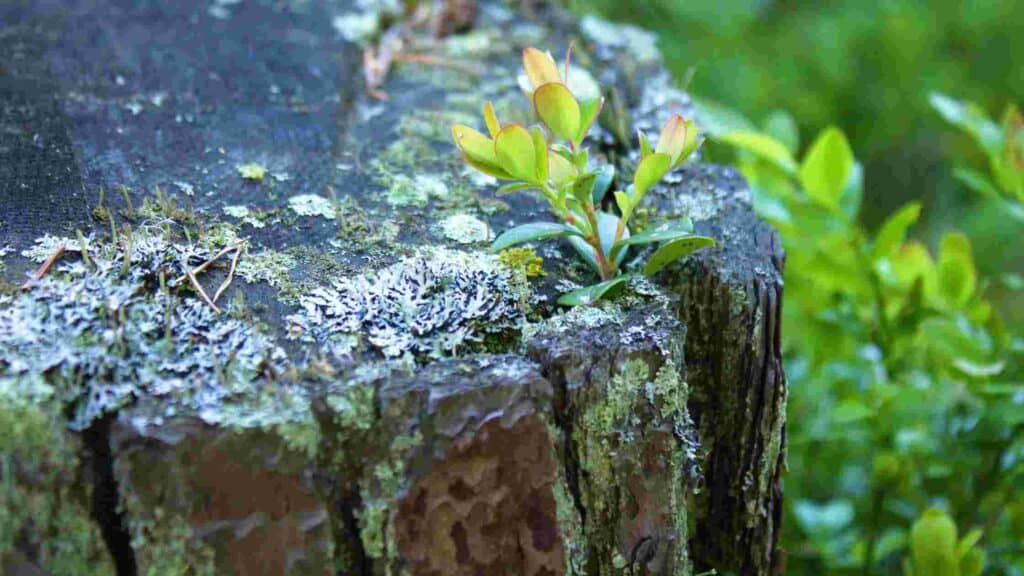In this article, we’ll delve into effective strategies on how to stop tree stumps from sprouting after tree removal.
You might be in a position where you have successfully bid farewell to that troublesome tree that caused endless headaches with your sidewalks and foundations. Now, all that remains is the stubborn tree stump.
But here’s the thing – the tree may be gone, but the stump isn’t completely lifeless. Without swift action, sprouts will emerge, not necessarily from the stump itself, but from distant living roots underground.
How To Stop Tree Stumps From Sprouting
To ensure regrowth prevention, two primary methods come into play: chemical sprays and stump grinding (you may also be interested in finding out how to remove a tree stump without a grinder).
How To Stop Tree Sprouts Using Chemical Treatments

When it comes to controlling tree sprouts, chemical treatments can be a potent weapon in your arsenal, despite their higher toxicity.
These treatments have the power to halt sprouts in their tracks, effectively preventing your tree stump from sprouting again.
Let’s explore the best practices for using chemical treatments to combat tree sprouts and ensure long-lasting results.
1. Timing Is Key
To maximize the effectiveness of a stump killer, timing is crucial.
The ideal time to apply a stump killer is immediately after the tree has been cut down. Suckers can sprout surprisingly quickly, so the sooner you take action, the better (find out the best tree stump killer).
2. Drilling Holes And Applying Herbicide
One effective method involves drilling holes at least 8 inches deep into the stump and pouring herbicide directly into them.
Typically, these herbicides come in a powdered form that can be easily mixed with water and poured into the holes. It’s worth exploring specialized tree stump killer products, as there may be options specifically developed for the roots of your particular tree.
Another environmentally friendly alternative is the use of Epsom salts, which can be effective if used promptly. The process is the same – drill holes and apply the salts.
However, bear in mind that the results may take a bit longer, as the concentration of Epsom salts is not as potent as non-organic products.
3. Stump Killing Herbicide
If you’ve missed the opportunity for immediate action, a more general “broadleaf” herbicide with a glyphosate base will prove more effective. These herbicides should be used with caution, as they can harm more than just the tree stump.
It’s important to spray them directly on the sprouts on a calm day, as multiple applications will likely be necessary due to the widespread nature of the roots.
4. Respectful Use Of Non-Organic Sprays
Non-organic sprays can effectively kill the roots, but it’s essential to treat these products with respect. Ensure they are safely stored and out of reach of children.
Keep in mind that these sprays will linger in the soil, making it challenging to plant new trees or other plants.
Remember, these sprays are designed for general weed killing, and your tree sucker problem has essentially become a persistent pest.
How To Keep Tree Stumps From Sprouting Using Stump Grinding

Employing the services of a professional is the quickest and easiest way to tackle this.
When hiring someone to cut down your tree, inquire if they possess a stump grinder. This specialized equipment grinds the stump below ground level, effectively shredding it. Ideally, the grinding should reach a depth of at least 6-12 inches below the ground surface.
However, if you opt for the more cost-effective DIY route and decide to rent a stump grinder, exercise caution (check out how to grind a tree stump).
Inadequate grinding may lead to suckers sprouting from the stump, resulting in more work than you bargained for. Once the stump is fully ground, the root system will gradually begin to decay.
Combining Methods For Effective Removal
Some garden specialists recommend manually digging out the sprouts as soon as they emerge. For optimal removal, dig below the soil surface, aiming to reach the depth of the roots whenever possible.
Although this approach requires time and effort, it can be combined with a chemical-based method to achieve satisfying results.
What Does It Mean When A Stump Is Sprouting?
When you spot suckers popping up in the middle of your lawn, it’s a clear indication that you’ve missed the window for the most effective action.
These suckers draw energy from the remaining food reserves in the root system, growing stronger than ever and tormenting you with their stubborn refusal to go away easily.
Another unexpected issue arises from water sprouts, which emerge from the stump due to vigorous pruning of dormant buds on branches.
It’s crucial to recognize this as a misunderstanding on the tree’s part – it thinks it’s simply receiving a long-overdue haircut, while you desire complete removal. Hence, when contemplating tree removal, thorough stump removal becomes essential to prevent any regrowth.
FAQs
1. Will vinegar get rid of a tree stump?
Vinegar alone is not effective in getting rid of a tree stump. It may help with inhibiting regrowth or killing small plants, but it’s not a reliable method for complete stump removal.
2. How do you kill tree roots that keep sprouting?
To kill tree roots that keep sprouting, you can cut them back and apply a systemic herbicide directly to the cut ends. Repeat this process as necessary.
3. How do you stop trees from sending up shoots?
To stop trees from sending up shoots, you can regularly prune and remove any suckers or sprouts as soon as they appear. Additionally, applying a growth inhibitor or pruning sealant to the cut areas may help prevent regrowth.
4. Will painting a tree stump stop it from growing?
Painting a tree stump will not stop it from growing. The growth of a tree stump depends on the living tissue within the stump and painting it will not impact its growth or regenerative ability.
5. How do you prevent a bush stump from growing back?
To prevent a bush stump from growing back, you can try cutting it as close to the ground as possible and regularly removing any regrowth. Applying a herbicide to the cut stump can also help inhibit regrowth.
6. How to stop a tree from growing without killing it?
It is not possible to stop a tree from growing without killing it. Trees require growth to thrive. If you want to control the size of a tree, regular pruning and trimming are necessary to maintain its desired shape and size.
7. Is there a homemade tree stump killer?
Yes, there are homemade tree stump killers that can be made using ingredients like Epsom salt, rock salt, or a mixture of vinegar and water. However, the effectiveness of homemade stump killers varies and is not as potent or reliable as commercial herbicides.
It’s important to note that using homemade stump killers requires multiple applications and will take longer to fully kill the stump compared to professional-grade products.
Final Thoughts: How To Stop Tree Sprouts From Stump
Trees are persistent living organisms, and it takes some effort to halt their natural processes.
For complete removal of trees and to minimize sucker growth, it’s often best to seek the advice of a local arborist or tree service. These professionals can guide you on the quickest and most effective ways to remove the tree entirely while maintaining a safe environment for all.
By following the recommended techniques and staying proactive, you can successfully control tree sprouts and enjoy a harmonious environment free from their persistent presence.
